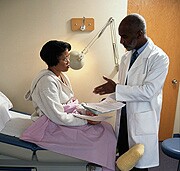It’s safer, cheaper than other types of imaging, doctors say
WEDNESDAY, April 1, 2015 (HealthDay News) — Ultrasound should be the first type of imaging used to assess pelvic symptoms in women, a team of obstetricians and gynecologists write in an article published in the April issue of the American Journal of Obstetrics & Gynecology.
The authors support an American Institute of Ultrasound in Medicine initiative called Ultrasound First, which urges doctors to use ultrasound when evidence shows that it is equally, if not more, effective compared to other imaging methods for the area on the patient’s body that requires examination.
“This recommendation applies particularly to obstetric and gynecologic patients. A skillfully performed and well-interpreted ultrasound usually eliminates the need to perform additional more costly and complex cross-sectional imaging techniques,” lead author and institute president Beryl Benacerraf, M.D., said in a journal news release. Currently, many women with pelvic pain, masses, or flank pain first undergo computed tomography (CT) scans, and sometimes magnetic resonance imaging (MRI), noted Benacerraf, who is also a clinical professor in obstetrics, gynecology, and reproductive biology and radiology at Harvard Medical School and Brigham and Women’s Hospital in Boston. However, CT scans and MRIs of the pelvis often result in unclear findings that require further clarification using ultrasound, she said.
Moreover, the growing use of CT raises safety concerns, added article coauthor Steven Goldstein, M.D., professor of obstetrics and gynecology at the NYU School of Medicine in New York City. “The use of CT scans has tripled since 1993,” Goldstein said in the news release, noting that radiation associated with CT may pose a cancer risk. It’s estimated that 29,000 future cancers could be related to CT done in the United States in 2007 alone, Goldstein added. And nearly half of those predicted cancers were attributed to CT of the pelvis and abdomen, he said.
Copyright © 2015 HealthDay. All rights reserved.








